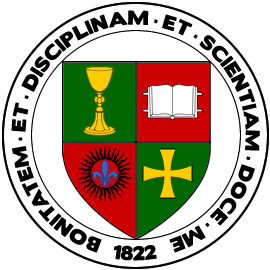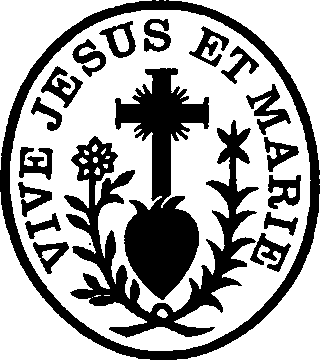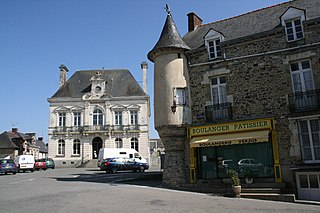
Acadia was a colony of New France in northeastern North America which included parts of what are now the Maritime provinces, the Gaspé Peninsula and Maine to the Kennebec River.

Bathurst is a city in northern New Brunswick with a population of 12,157 and the 4th largest metropolitan area in New Brunswick as defined by Census Canada with a population of 31,387 as of 2021. The City of Bathurst overlooks Nepisiguit Bay, part of Chaleur Bay and is at the estuary of the Nepisiguit River.

The Congregation of St. Basil, also called the Basilians, is a Catholic clerical religious congregation of pontifical right for men, with priests, seminarians and lay associates. It is an apostolic community whose members profess simple vows. The Basilians work in education and evangelization. The congregation was founded in 1822 in the aftermath of the French Revolution. In the early 19th century, the Basilians' educational and pastoral work brought them to a variety of locations in Canada and the United States. In the 1960s, the priests began to minister in Mexico, and in Colombia in the 1980s.

The Université de Moncton is a Canadian francophone university in New Brunswick. It includes campuses in Edmundston, Moncton, and Shippagan.

Shippagan is a Canadian town within Shippegan Parish, Gloucester County, New Brunswick.

The University of St. Joseph's College was the leading Acadian cultural institution, an Acadian Catholic university in Memramcook, New Brunswick that closed in 1966, when it was forced to be amalgamated with two other Catholic Acadian colleges to form the secular Université de Moncton. The process of amalgamation excluded a full reflection of the founding Catholic Culture of the Acadian people, fostering a colonizing secularization of Acadian life. The Collège Saint-Joseph, the Université Sacré-Cœur in Bathurst, and the Université Saint-Louis d'Edmundston suspend their respective charters and assume the status of affiliated colleges in the secular Université de Moncton, named after the city of Moncton, which in turn was named after General Robert Monckton the British General who directed the Acadian deportation.
Jacques-François Dujarié (1767-1838) was a French Catholic priest who served the people of France at the start of the 19th century. To this end, he founded a congregation of religious sisters and another one of brothers.

The Congregation of Jesus and Mary, abbreviated CIM or (CJM) also known as the Eudists, is a society of apostolic life of Pontifical Right for men in the Catholic Church. It was established on March 25, 1643 by Saint Fr. John Eudes, C.I.M.

John Eudes, CIM was a French Catholic priest and the founder of both the Order of Our Lady of Charity in 1641 and Congregation of Jesus and Mary, also known as The Eudists, in 1643. He was also a professed member of the Oratory of Jesus until 1643.

The Roman Catholic Diocese of Charlottetown is a diocese of the Catholic Church in Canada. It is a suffragan diocese comprising the entire province of Prince Edward Island.

Louis Joseph Napoléon Paul Bruchési was a Canadian prelate, the second Archbishop of Montreal. In 1910 he directed the 21st International Eucharistic Congress held in Montreal.

Louis Philippe Adélard Langevin was a Canadian Oblate priest and Archbishop of Saint-Boniface. He founded the La Liberté newspaper published in Manitoba on May 20, 1913.

The Diocese of Bathurst is a Roman Catholic suffragan of the Archdiocese of Moncton. It has its cathedral episcopal see, Sacred Heart Cathedral, in Bathurst, New Brunswick, Canada.

Janzé is a commune in the Ille-et-Vilaine department in Brittany in northwestern France. It is also the seat of the Canton of Janzé. The inhabitants of Janzé are called Janzéens in French.

Caraquet is a town in Gloucester County, New Brunswick, Canada.

Marcel-François Richard was a Roman Catholic priest and a Canadian educator. He played an important part in the development of the Acadian people.
Mathilda Blanchard was a Canadian labour leader. She was nicknamed la pasionaria acadienne due to her engagement and defense of Acadian workers in New Brunswick, particularly in the seafood trade.

Sainte-Anne-du-Bocage, or simply Le Bocage, is a Catholic sanctuary in Caraquet, New Brunswick (Canada).

The Louis Mailloux Affair was a series of violent events similar to a jacquerie that occurred in the town of Caraquet, New Brunswick (Canada), in January 1875.
Acadian theatre refers to theatrical productions that originate from or are perceived as originating from Acadia. The most prominent playwright is Antonine Maillet, whose play La Sagouine has been staged over two thousand times, with Viola Léger as the sole Actor.



























